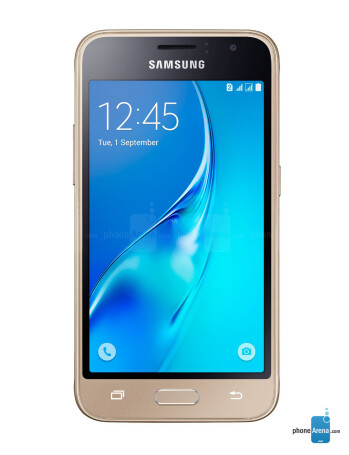Table of Contents
Samsung Galaxy J1 2016 price, specs, features, comparison
-
Processor: Quad-core Spreadtrum SC9830
-
RAM: 1 GB
-
Storage: 8 GB
-
Display: 4.5 inches
-
Camera: 5 MP + 2 MP
-
Operating System: Android 5.1.1 (Lollipop)
Our Rating
The total ranking is based on our editors’ evaluation.
-
Design 5 / 10
-
Display 6 / 10
-
Camera 5 / 10
-
Features 5 / 10
-
Connectivity 6 / 10
-
Usability 6 / 10
-
Performance 5 / 10
-
Battery 6 / 10
Samsung Galaxy J1 2016 – SPECIFICATIONS
-
ModelSamsung Galaxy J1 2016
-
ReleasedJanuary 2016
-
StatusAvailable
Design
- Type Design Type : The size, shape, and appearance of a mobile phone, as well as the arrangement and placement of essential components, are referred to as form factor. In mobile phones, there are three major form factors: bar phones, folding phones, and sliding phones.
Bar - Dimensions 132.6 x 69.3 x 8.9 mm
- Weight 131 g
Display
Display Type Display Technology => TFT (Thin Film Transistor), IPS (In-Place Switching), OLED (Organic Light Emitting Diode), AMOLED (Active-Matrix Organic Light-Emitting Diode), Super AMOLED (an even more advanced version of AMOLED), Resistive Touchscreen (Resistive touchscreens contain two layers of conductive material with a very small gap between them that acts as a resistor) are some of the display technologies and types (Capacitive touchscreen technology consists of a layer of glass coated with a transparent conductor)
- Size 4.5 inches
- Resolution 480 x 800 pixels
- Display Colors : The number of various shades of color that the screen can display => 64K colors, 256K colors, and 16 million colors. Obviously, 16M is the maximum accessible range of colors and is superior than the others.
16 millimeter - Pixel Density (PPI) : is the pixel density on a given display, measured in pixels per inch (ppi). Pixel density is determined by dividing a display’s diagonal pixel resolution by its diagonal dimension; the higher the pixel density, the better the display quality.
-
Touch ScreenYes
-
Featurescapacitive touchscreen
Hardware
- GPU : (Graphics Processing Unit) is a single-chip processor that manipulates and alters memory quickly to speed up the production of images in a frame buffer meant for display. This includes lighting effects, object transformations, and 3D motion.
- RAM (Memory) : (Random Access Memory) is a sort of computer memory that allows information to be stored and accessed fast from random locations. Any byte of memory can be accessed without touching the bytes before it. The most prevalent type of memory in computers, smartphones, tablets, and other electronic devices is RAM.
1 Gigabyt - Internal Storage : is a data storage space (flash memory) that is commonly found in smartphones, tablets, and other electronic devices, and is used to store the operating system, apps, music, images, videos, files, and other user data.
8 GB - Memory Card Slot : is a memory card slot that can be used to insert a memory card. You can use memory cards to expand the phone’s built-in memory. A memory card (also known as a flash memory card or a storage card) is a compact storage medium for storing data such as text, photos, audio, and video on small, portable, or remote computing devices such as mobile phones, mp3 players, and digital cameras.
up to 256 GB - Sensors : are electronic components that detect and respond to information from the physical world in some way. Light, heat, motion, moisture, pressure, and location are examples of specific inputs. A location sensor, such as a GPS receiver, may determine the present location of your electronic device, and the output is usually a signal that is converted for use in computing systems.
proximity sensor, accelerometer
Software
Operating System OS => Every computer system is based on a piece of software known as an operating system (OS). The operating system is in charge of the computer’s essential functions (such as smartphone, PDAs, tablet computers and other handheld devices). The Operating System allows the user to download and execute third-party software (apps), which are used to enhance the device’s functionality.
5.1.1 Android (Lollipop)
Camera
- Rear Camera : is capable of taking photos and, in most cases, movies, The resolution (measured in megapixels) and lens focus type (fixed or automated) are the most essential qualities of a camera. Higher megapixel cameras are known to capture higher quality images, however this is not necessarily an accurate indication of the photos quality.
Autofocus, 5 MP, f/2.2
-
Video720p@30fps
- Flash Light => In most camera mobile phones, there are two types of flash lights: Xenon Flash (xenon flash produces an extremely intense full-spectrum white light for a very short duration), LED Flash (LED flash offers lower power consumption with drive circuitry that takes up very little space, LEDs can be strobed faster than any other light source), LED Flash (LED flash offers lower power consumption with drive circuitry that takes up very little space, LEDs can be strobed faster than any other light source), LED Flash (LED flash offers lower power consumption with drive circuitry that takes up very little
-
Front Camera2 MP, f/2.2
